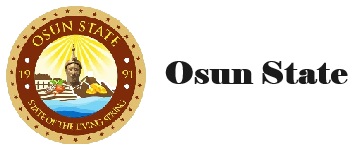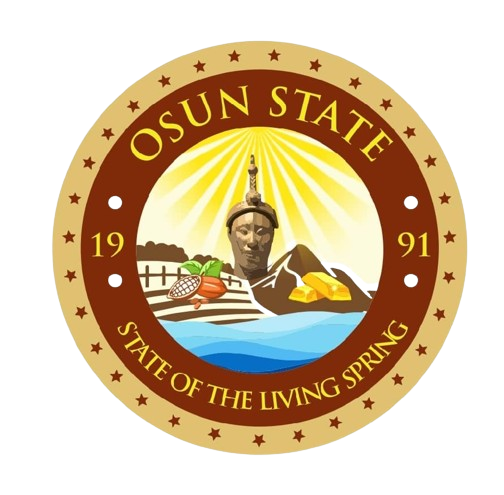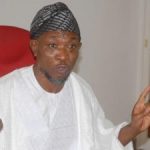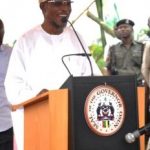OPINION: Understanding Osun Politics, By Niyi Akinnaso

One major problem with many a reporter is the tendency to exaggerate or even concoct facts in the struggle for exclusivity in reporting a story. Jayson Blair, who was forced to resign from The New York Times in May 2003 was such a reporter. In a subsequent lengthy article by a team of Time’s journalists, it was revealed that “He fabricated comments. He concocted scenes. He lifted material from other newspapers and wire services. He selected details from photographs to create the impression he had been somewhere or seen someone, when he had not” (The New York Times, May 11, 2013).
Another problem is the tendency to develop a sensational, and often misleading, caption for a story in order to capture the readers’ attention. Such was the case with many newspaper reports of the theft of Governor Rauf Aregbesola’s mobile phone in 2013 in which attention was drawn to the wrong quarters. The two problems I just identified detract from the noble journalistic purposes of informing and educating the public, while also putting the government on its toes. And they should be discouraged.
Yet, these are among the problems that pervade newspaper reports about contemporary Osun politics, featuring Aregbesola and his development projects in the state. A further disadvantage of distorted reports is in generating misleading data upon which arm-chair commentators base their opinion. As I read hundreds of reports, commentaries, and editorials on Aregbesola and Osun politics in the last three years, my mind often decided to investigate the facts. In what follows, I share some of my findings with the public.
Osun’s demography and political divisions are particularly interesting, and they should be understood before dabbling in the state’s politics. Although 28th out of 36 states in land size, Osun is 17th in population at about 3.5 million. Curiously, although smaller in size and population than Ondo, Osun has 30 Local Government Areas, whereas Ondo has only 18. While the relatively large number of LGAs may be useful in bringing the government closer to the people, it is a disadvantage when it comes to overhead costs, especially in the light of Osun’s limited resources.
The religious composition of Osun is even more interesting, featuring a predominant Muslim population; a minority Christian population; and a dwindling population of traditionalists affiliated with Ifa, Osun, and other deities. A unique feature of Christianity in the state is the early presence of the major denominations, notably, Baptist, Methodist, and Anglican, and the emergence of Evangelical Churches, with the Christ Apostolic Church in the forefront. No wonder then that Osun is the natal home of many contemporary religious leaders in the country, including Pastor Enoch Adeboye, the General Overseer of the Redeemed Christian Church of God, and Pastor William Kumuyi, the Founder and General Superintendent of the Deeper Life Bible Church.
Worshippers of Traditional Religion are not left out either. The Osun Osogbo Grove, declared a World Heritage Site in 2005, attracts worshippers and tourists from all over the world every August, during the annual rites of the Osun deity. Anthropological research also reveals that there are renowned Ifa priests across the state, especially at Ife, Ede, and Osogbo. Although despised by Christians, Muslims, and modernists, these traditionalists are prime custodians of Yoruba tradition. Osun also has a significant share of old settlements, such as Ile-Ife, Ede, and Ila-Orangun, which have played a major role in Yoruba history.
The intersections among history, culture, religion, and politics have been a feature of Osun social life since the inception of the state in 1991. The more a government seeks to reach more people and areas of social life, the more controversy is generated along various social cleavages. This is particularly true of the religious divide between Muslims and Christians. It is a divide that political opponents often exploit and to which Aregbesola has fallen victim on various occasions
Two recent examples of the political exploitation of religion by critics and opponents are Aregbesola’s plan to build an inter-denominational worship centre and the orchestrated uniform crisis at the Baptist High School, Iwo. In both cases, the real issues were sidetracked. No one wanted to recognise the commercialisation of religion in Nigeria, and the need for Osun to seek economic benefits from building a worship centre that would attract thousands of buyers and sellers to the state. The real issue must be with Aregbesola. Aregbesola is building a worship centre only to placate Christians who are purportedly displeased with his educational policy. He must be taught about the separation of Church and State. We must take religion out of schools. We must stop Aregbesola from Islamising Osun. All bombastic statements of no consequence.
What about the educational policy that created the context for the uniform crisis? Well, religion is still the story, because it was the hijab worn by some female students that led others to wear their own religious insignia; it doesn’t even matter if only a handful of students were involved in a student population of 2,500. And it doesn’t matter if the crisis was so localised that it only happened in one school!
In the ensuing discussion about the uniform crisis, the education policy that gave rise to the uniform was ignored. Who cares about educational policy anyway? I remember the response given by someone, who claimed to know Osun very well, when asked to describe aspects of Aregbesola’s educational policy he knew well. He gave a one-word answer: Hijab. The response highlights the sensationalisation of hijab in news stories about the ongoing educational reform in the state. I consider this very unfortunate, given how much I know about the policy and how well it reflects best practices in advanced countries to which the elite send their children for training.
The good thing, though, is that the policy is working, because it is an excellent one. Elementary school kids in the state are fed every school day. The first batch of Opon Imo went to final year High School students, who are graduating soon. Incentives and capacity building for teachers over a 4-year period have resulted in a dramatic improvement in the School Leaving Certificate Exams. Four years ago, only about seven per cent of High School students in the state had five credits, including English and Mathematics. Today, it is 47 per cent. This figure should improve when the ongoing reforms kick in fully.
Another aspect of the educational reform that has eluded discussion is what I call “collateral” . First, the plan to build 100 Elementary, 50 Middle, and 20 High Schools is an employment booster for the next few years. Already, many families are being sustained by the ongoing construction of these schools across the state. So far, 14 Elementary, 15 Middle, and two High Schools have been completed.
Second, the policy of providing lunch for all Osun schoolchildren in Elementary Grades 1-4 has led to the employment of over 3,000 food vendors across the state. Each one was given an interest-free loan to purchase necessary equipment and empowered to also cater for profit in their localities. Moreover, thousands of farmers were provided with loans for poultry farming, while interested youths were empowered for fish farming.
Third, the school uniform policy led to the establishment of a garment factory, which now employs hundreds of youths from across the state. Viewed from the perspective of employment generation alone, Aregbesola’s educational policy has made a significant impact already.
I use the education sector simply to illustrate one point. We should strive to get beneath the surface in news reporting and commentaries. If we don’t, we run the risk of misleading the public.
Another problem is the tendency to develop a sensational, and often misleading, caption for a story in order to capture the readers’ attention. Such was the case with many newspaper reports of the theft of Governor Rauf Aregbesola’s mobile phone in 2013 in which attention was drawn to the wrong quarters. The two problems I just identified detract from the noble journalistic purposes of informing and educating the public, while also putting the government on its toes. And they should be discouraged.
Yet, these are among the problems that pervade newspaper reports about contemporary Osun politics, featuring Aregbesola and his development projects in the state. A further disadvantage of distorted reports is in generating misleading data upon which arm-chair commentators base their opinion. As I read hundreds of reports, commentaries, and editorials on Aregbesola and Osun politics in the last three years, my mind often decided to investigate the facts. In what follows, I share some of my findings with the public.
Osun’s demography and political divisions are particularly interesting, and they should be understood before dabbling in the state’s politics. Although 28th out of 36 states in land size, Osun is 17th in population at about 3.5 million. Curiously, although smaller in size and population than Ondo, Osun has 30 Local Government Areas, whereas Ondo has only 18. While the relatively large number of LGAs may be useful in bringing the government closer to the people, it is a disadvantage when it comes to overhead costs, especially in the light of Osun’s limited resources.
The religious composition of Osun is even more interesting, featuring a predominant Muslim population; a minority Christian population; and a dwindling population of traditionalists affiliated with Ifa, Osun, and other deities. A unique feature of Christianity in the state is the early presence of the major denominations, notably, Baptist, Methodist, and Anglican, and the emergence of Evangelical Churches, with the Christ Apostolic Church in the forefront. No wonder then that Osun is the natal home of many contemporary religious leaders in the country, including Pastor Enoch Adeboye, the General Overseer of the Redeemed Christian Church of God, and Pastor William Kumuyi, the Founder and General Superintendent of the Deeper Life Bible Church.
Worshippers of Traditional Religion are not left out either. The Osun Osogbo Grove, declared a World Heritage Site in 2005, attracts worshippers and tourists from all over the world every August, during the annual rites of the Osun deity. Anthropological research also reveals that there are renowned Ifa priests across the state, especially at Ife, Ede, and Osogbo. Although despised by Christians, Muslims, and modernists, these traditionalists are prime custodians of Yoruba tradition. Osun also has a significant share of old settlements, such as Ile-Ife, Ede, and Ila-Orangun, which have played a major role in Yoruba history.
The intersections among history, culture, religion, and politics have been a feature of Osun social life since the inception of the state in 1991. The more a government seeks to reach more people and areas of social life, the more controversy is generated along various social cleavages. This is particularly true of the religious divide between Muslims and Christians. It is a divide that political opponents often exploit and to which Aregbesola has fallen victim on various occasions
Two recent examples of the political exploitation of religion by critics and opponents are Aregbesola’s plan to build an inter-denominational worship centre and the orchestrated uniform crisis at the Baptist High School, Iwo. In both cases, the real issues were sidetracked. No one wanted to recognise the commercialisation of religion in Nigeria, and the need for Osun to seek economic benefits from building a worship centre that would attract thousands of buyers and sellers to the state. The real issue must be with Aregbesola. Aregbesola is building a worship centre only to placate Christians who are purportedly displeased with his educational policy. He must be taught about the separation of Church and State. We must take religion out of schools. We must stop Aregbesola from Islamising Osun. All bombastic statements of no consequence.
What about the educational policy that created the context for the uniform crisis? Well, religion is still the story, because it was the hijab worn by some female students that led others to wear their own religious insignia; it doesn’t even matter if only a handful of students were involved in a student population of 2,500. And it doesn’t matter if the crisis was so localised that it only happened in one school!
In the ensuing discussion about the uniform crisis, the education policy that gave rise to the uniform was ignored. Who cares about educational policy anyway? I remember the response given by someone, who claimed to know Osun very well, when asked to describe aspects of Aregbesola’s educational policy he knew well. He gave a one-word answer: Hijab. The response highlights the sensationalisation of hijab in news stories about the ongoing educational reform in the state. I consider this very unfortunate, given how much I know about the policy and how well it reflects best practices in advanced countries to which the elite send their children for training.
The good thing, though, is that the policy is working, because it is an excellent one. Elementary school kids in the state are fed every school day. The first batch of Opon Imo went to final year High School students, who are graduating soon. Incentives and capacity building for teachers over a 4-year period have resulted in a dramatic improvement in the School Leaving Certificate Exams. Four years ago, only about seven per cent of High School students in the state had five credits, including English and Mathematics. Today, it is 47 per cent. This figure should improve when the ongoing reforms kick in fully.
Another aspect of the educational reform that has eluded discussion is what I call “collateral” . First, the plan to build 100 Elementary, 50 Middle, and 20 High Schools is an employment booster for the next few years. Already, many families are being sustained by the ongoing construction of these schools across the state. So far, 14 Elementary, 15 Middle, and two High Schools have been completed.
Second, the policy of providing lunch for all Osun schoolchildren in Elementary Grades 1-4 has led to the employment of over 3,000 food vendors across the state. Each one was given an interest-free loan to purchase necessary equipment and empowered to also cater for profit in their localities. Moreover, thousands of farmers were provided with loans for poultry farming, while interested youths were empowered for fish farming.
Third, the school uniform policy led to the establishment of a garment factory, which now employs hundreds of youths from across the state. Viewed from the perspective of employment generation alone, Aregbesola’s educational policy has made a significant impact already.
I use the education sector simply to illustrate one point. We should strive to get beneath the surface in news reporting and commentaries. If we don’t, we run the risk of misleading the public.



